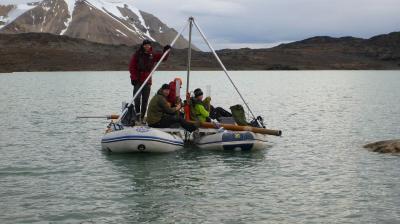They also discovered that Svalbard was not particularly cold during the recent "Little Ice Age" of the 18th and 19th centuries, when glaciers on Svalbard surged to their greatest extent in the last 10,000 years and glaciers in many parts of Western Europe also grew. They suggest that snow, rather than colder temperatures, may have fed the growth of Svalbard glaciers.
The naturally driven Medieval Warm Period occurred from about 950 to 1250 and obviously there were no industrial greenhouse gases then so the surge and decline in temperature has been a puzzle for scientists. The climate model from Svalbard says it casts new doubt on that era's reach and notes that since 1987, summers on Svalbard have been 2 degrees to 2.5 degrees C (3.6 to 4.5 degrees F) hotter than they were there during warmest parts of the Medieval Warm Period, the study found.
How do they determine it, since thermometer readings before 30 years ago were inconsistent and inaccurate? They analyzed levels of unsaturated fats in algae buried in the sediments of Kongressvatnet lake, in western Svalbard. In colder water, algae make more unsaturated fats, or alkenones; in warmer water, they produce more saturated fats. Like tree rings, the unsaturation level of fats can provide a record of past climate. Most Arctic climate records have come from ice cores that preserve only annual layers of cold-season snowfall, and thus cold-season temperatures but lake sediments, with their record of summertime temperatures, can tell scientists how climate varied the rest of the year and in places where ice sheets are absent.
Evidence from tree rings and ice cores shows that southern Greenland and parts of North America were warmer from 950 to 1250 than today, with the Vikings taking advantage of ice-free waters to settle Greenland. Some regions also saw prolonged drought, including California, Nevada and the Mississippi Valley, leading some scientists to coin the alternate term Medieval Climate Anomaly to emphasize the extreme shift in precipitation rather than temperature. A natural increase in solar radiation during this time was deemed responsible for warming parts of the northern hemisphere, with a rise in volcanic activity from 1100 to 1260 causing milder winters.
Western Svalbard began to gradually warm in 1600, the researchers found, when the northern arm of the Gulf Stream, known as the West Spitsbergen Current, may have brought more tropical water to the region. In 1890, the warming began to accelerate, with researchers attributing most of the warming since about 1960 to rising industrial greenhouse gas levels. Ice cores from Svalbard, by contrast, show a slight cooling over the last 1,800 years. The conflicting evidence suggests that temperatures may have fluctuated more sharply between winter and summer, said Anne Hormes, a quaternary geologist at the University Centre in Svalbard who was not involved in the study.

Coring platform atop two inflatable rafts. Scientists in Svalbard can raise sediment cores from the lake bed below. Credit: Jostein Bakk
"The Medieval Warm Period was not as uniformly warm as we once thought--we can start calling it the Medieval Period again," the study's lead author, William D'Andrea, a climate scientist at Columbia University's Lamont-Doherty Earth Observatory, said in a statement. "Our record indicates that recent summer temperatures on Svalbard are greater than even the warmest periods at that time."
D'Andrea and his colleagues dated their lake cores by analyzing grains of glass spewed by volcanoes hundreds of miles away in Iceland. Those past eruptions-- Snæfellsjökull in 170, Hekla in 1104 and Öræfajökull in 1362--all left unique chemical time markers on Svalbard's lake sediments. "We know fairly precisely when these eruptions occurred, which is rare in the geologic record," said study co-author Nicholas Balascio, a scientist at University of Massachusetts, Amherst.
Recent temperature measurements show that the Arctic is warming twice as fast as the rest of the planet, with sea ice this summer shrinking to its smallest extent on record. Natural feedbacks are amplifying the warming as loss of reflective sea ice causes the ocean to absorb more of the sun's energy, melting more sea ice, which causes more energy absorption, and so on. Climate models suggest that by 2100 Svalbard will warm more than any other landmass on earth, due to a combination of sea-ice loss and changes in atmospheric and oceanic circulation, according to the International Panel on Climate Change 2007 report. In a study published last year in the journal Advances in Meteorology, Norwegian researchers estimate that average winter temperature in Svalbard could rise by as much as 10 degrees C, or 18 degrees Fahrenheit.
Published in Geology






Comments